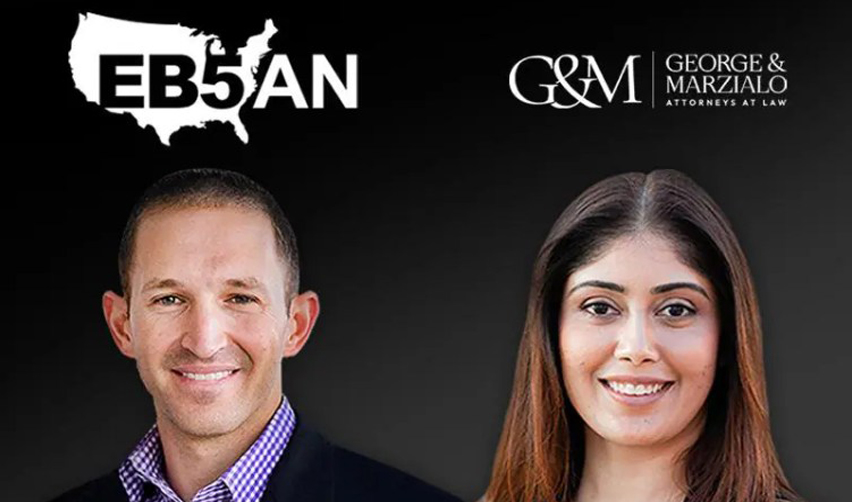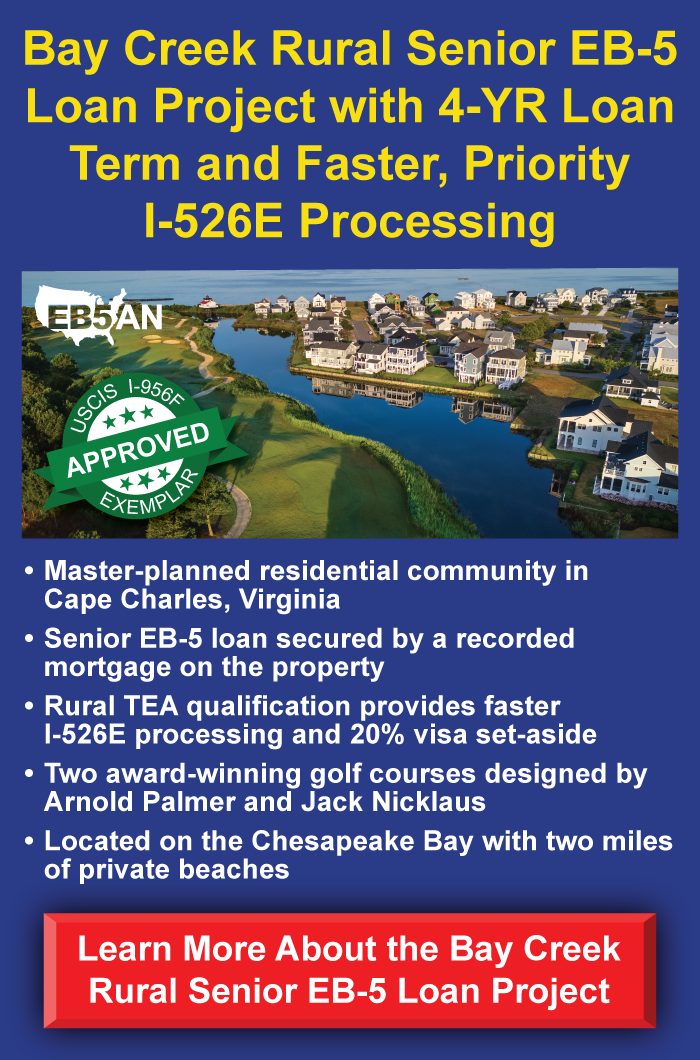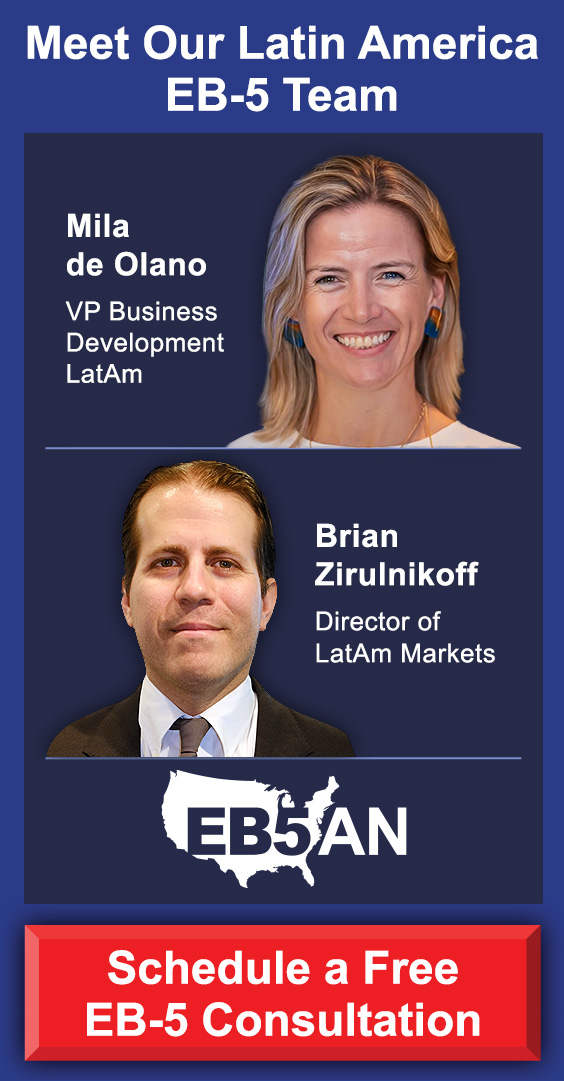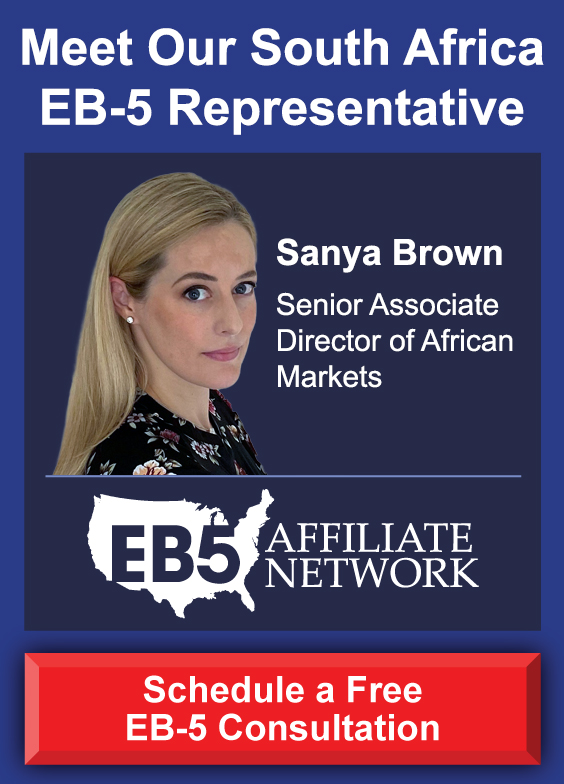This is a joint article written by Sam Silverman, managing partner of EB5AN, and Anahita George, Esq., a leading immigration attorney specializing in EB-5 applications.
Sam has extensive real estate development, management, financing, and brokerage experience across several U.S. states and internationally in China. Before co-founding EB5AN, he served as the Director of Corporate Strategy and Expansion for Jack Nicklaus in Beijing and previously worked at the Boston Consulting Group, advising Fortune 500 companies in multiple industries worldwide. Sam is a leading EB-5 expert regularly cited by The Wall Street Journal and other publications.
A partner at the law firm George & Marzialo, Anahita has filed nearly 3,000 EB-5 petitions with a 100% USCIS approval rate. She has applied her expertise in tax and finance as an auditor at PricewaterhouseCoopers and KPMG, where she audited Fortune 500 companies such as Walmart and the Walt Disney Company.
In the past few weeks, multiple EB-5 investors have faced the harshest possible adjudication decision from USCIS: an outright denial of their I-526E petitions. In these cases, USCIS did not issue a request for evidence (RFE) or even a notice of intent to deny (NOID). Instead, the agency went straight to denial—an unusually severe step that underscores the seriousness of the issue.
What mistake did these investors make? Each investor used loaned funds from an entity controlled by the same regional center sponsoring their EB-5 project.
This practice, which may be presented as a convenient solution for investors short on funds, directly violates USCIS policy. And the consequences are serious for EB-5 applicants: denial of their I-526E petition and, effectively, the loss of the investor’s U.S. immigration process.
As Anahita George, Esq, explains, “We are now seeing denials that leave no room for interpretation—if even part of your EB-5 capital comes from a loan tied to the regional center, your case will be denied. USCIS has made this point with absolute clarity.”
Even though USCIS may have approved similar I-526Es in the past, the agency is evidently realizing that this is a clear violation of EB-5 policy. We strongly caution all EB-5 investors against using funds loaned from a regional center or from a related entity.
Doing so will put you on the path to a swift USCIS denial.
Moreover, regional centers that offer such loans are not only showing clear disregard for USCIS policy—they are also putting their investors’ immigration outcomes at risk, likely for the sake of gaining faster access to capital.
In this post, we’ll examine how these circular loans from regional centers violate multiple rules of the EB-5 program and why the agency is taking such strong measures against these loan arrangements. We’ll then explore how EB-5 investors can avoid these risky projects and the steps to take for investors who have already received an I-526E denial.
The Source-of-Funds Requirement in EB-5
USCIS Specifically Prohibits Loans fFom Regional Centers
The Risks for EB-5 Investors
How USCIS Views These Circular Loans
How EB-5 Investors Can Avoid USCIS Denials
Protect Your Immigration Goals—Avoid Loans From Regional Centers
The Source-of-Funds Requirement in EB-5
Every EB-5 investor must prove that their investment funds are lawfully sourced and personally owned. This is not just a formality—it is one of the most crucial parts of the EB-5 process. USCIS carefully traces the path of every dollar to ensure compliance.
If USCIS identifies problems with an investor’s source of funds, the likely outcome is an RFE, a NOID, or outright denial.
In the recent cases at issue, USCIS has skipped the intermediate steps and went straight to denial—demonstrating just how serious the violations were.
Sam Silverman, managing partner of EB5AN, notes, “The message is crystal clear. USCIS will not tolerate EB-5 investments that include money loaned from regional centers or their affiliates. Investors must wholly own the funds they invest.”
Consider why it’s so important for EB-5 applicants to invest with their own funds.
What the Law Says
The Immigration and Nationality Act (INA) sets strict rules for gifted or loaned funds. Under the subsection “Gift and loan restrictions, section 203(b)(5)(L)(iii) of the INA says the following:
(I) In general
Gifted and borrowed funds may not be counted toward the minimum capital investment requirement under subparagraph (C) unless such funds-
(aa) were gifted or loaned to the alien investor in good faith; and
(bb) were not gifted or loaned to circumvent any limitations imposed on permissible sources of capital under this subparagraph, including but not limited to proceeds from illegal activity.
In other words, EB-5 investors can use loaned funds only if the loan is in good faith, not designed to evade program rules, and not sourced from impermissible entities. Since they do not meet the third of these standards, loans from regional centers or their controlled entities fail this test.
Suppose an investor has chosen to invest in a targeted employment area project to qualify for the lower investment threshold of $800,000. Now suppose the regional center sponsoring this project offers to loan the investor $300,000 as part of their $800,000 investment amount.
The regional center’s goal may be for the investor to file their Form I-526E as quickly as possible and gain faster access to the funds. But based on EB-5 program rules, the investor will not be reaching the $800,000 minimum investment amount. The investor is only investing $500,000—the remaining $300,000 is the regional center’s own capital, simply being recycled into another EB-5 project.
This is a clear attempt to “game the system” and, as the INA puts it, “circumvent [limitations] imposed on permissible sources of capital.”
Partial Investments
What about partial EB-5 investments, you may be wondering, where the investor contributes part of their $800,000 amount and then pledges to repay the rest by a specified date?
In most instances of partial investments, the investor’s remaining funds are usually secured by some form of collateral, and the investor is the sole provider of the invested funds—none of the investment can come from the regional center’s funds, which were likely derived from other EB-5 investors.
Put simply, whether using a partial or full investment, the investor must be the sole provider of all invested funds.
USCIS Specifically Prohibits Loans From Regional Centers
USCIS policy makes it clear: Funds loaned by a regional center or any affiliated entity do not count as EB-5 capital.
INA §203(b)(5)(D)(ii)(III) explicitly excludes “capital invested in exchange for a note, bond, convertible debt, obligation, or any other debt arrangement between the alien investor and the new commercial enterprise.”
In EB-5 capital, the new commercial enterprise (NCE) is the regional center’s investment fund set up for the EB-5 project. Naturally, the above restriction would also apply to any related entities.
These could be affiliates or so-called “third-party” entities that are in fact controlled by the same principals as the regional center. That’s why it’s crucial for investors to find out whether any entity offering a loan is linked to the regional center.
“When funds are loaned by the regional center itself,” Anahita George explains, “those funds often come from earlier EB-5 investors. That means no new capital is being introduced to the project—and no new jobs are being created. USCIS considers this a circular transaction, and it is not allowed.”
The Risks for EB-5 Investors
Accepting a loan from a regional center-controlled entity exposes investors to several risks:
- Outright Denial of their I-526E Petition: USCIS adjudicators view these arrangements as a blatant violation. In multiple recent cases, investors’ petitions were denied without RFEs or NOIDs.
- Loss of Immigration Benefits: Without an approved I-526E, the investor and their family cannot proceed to Green Cards. Years of planning and financial commitment may be wasted. And if you are already residing in the U.S., you may have to leave on short notice.
- Losing Funds in a Ponzi-Like Scheme: These arrangements often involve recycling funds already in the NCE. The SEC defines a Ponzi scheme as “an investment fraud that pays existing investors with funds collected from new investors.” Circular EB-5 loans share a dangerous resemblance to such schemes and make it unlikely for the EB-5 investors to be repaid.
“If a regional center is offering you a loan to cover your EB-5 capital,” Silverman warns, “that is a clear red flag. They are putting their access to your money ahead of your immigration success.”
How USCIS Views These Circular Loans
The recent I-526E denials show just how seriously USCIS takes this issue. Some of these denials have been over 60 pages long, listing in detail how loans from regional centers fail to comply with USCIS rules.
USCIS is sending a clear message: EB-5 capital must come from the investor and the investor alone. Any attempt to “game the system” with third-party funds will likely receive an outright denial.
In a prior EB5AN article, “EB-5 Investors, Never Accept a Loan From a Regional Center,” we warned investors about the compliance problems tied to loans from regional centers. Those predictions have now come true.
Consider these points from our previous article, which USCIS has likely indicated in its recent I-526E denials:
- Circular Capital: Funds are originating within the NCE itself. This is not a good-faith loan—it is a recycling of existing capital.
- No Job Creation: Because no new capital enters the project, no new jobs are created from the investor’s contribution.
- Funds Not at Risk: The funds were never truly owned by the investor, so they cannot be considered “at risk” as required by EB-5 rules.
- Unacceptable Source of Funds: The source-of-funds paper trail would lead back to earlier investors—something USCIS will not accept.
Each of these problems on its own could trigger an RFE, a NOID, or a denial. Together, they all but guarantee it.
How EB-5 Investors Can Avoid USCIS Denials
The key is for investors to do their research on any regional center and EB-5 project before investing and make sure they invest using their own funds.
If a regional center—or an affiliated third party—offers you a loan to complete your $800,000 investment, avoid them. This is not the same as a permissible partial investment.
Instead, choose only regional centers that prioritize compliance with USCIS rules and that never put investors’ immigration outcomes at risk.
What if you have already invested in such a project and received a denial? If you are in this situation, all is not necessarily lost, but your options are limited.
We advise you to work immediately with an immigration attorney who has a proven track record of I-526E approvals. Your attorney can assess whether a motion to reopen or refile is possible—or whether you should reinvest in a compliant project.
Anahita notes, “We offer free consultations to EB-5 investors who find themselves in these situations. The first step is understanding what USCIS flagged in your denial and exploring what remedies may exist.”
With EB-5 being such a complex process, many investors find themselves seeking help following a denial.
“EB-5 investors who have received I-526E denials often reach out to me,” Anahita adds, “and we work together on what we can do to salvage their immigration prospects.”
Schedule a Consultation With Anahita Today
Protect Your Immigration Goals—Avoid Loans From Regional Centers
The recent wave of I-526E denials is not a surprise. It is the predictable result of investors using funds that were never truly their own—ones loaned to them by entities controlled by the regional centers sponsoring their projects.
The law is clear. USCIS policy is clear. And the denials now arriving confirm that this practice is unacceptable.
According to Sam Silverman, “USCIS is drawing a line in the sand. Investors must contribute their own capital to the EB-5 program. Anything less will end in denial.”
EB-5 investors should take this warning seriously. Whether you’re filing a partial or full investment, avoid regional centers that offer loaned funds, and protect both your immigration future and your investment capital by ensuring full compliance with USCIS requirements.
If you have any questions regarding EB-5 source of funds or your investment options, please feel free to schedule a free consultation with our expert team.







